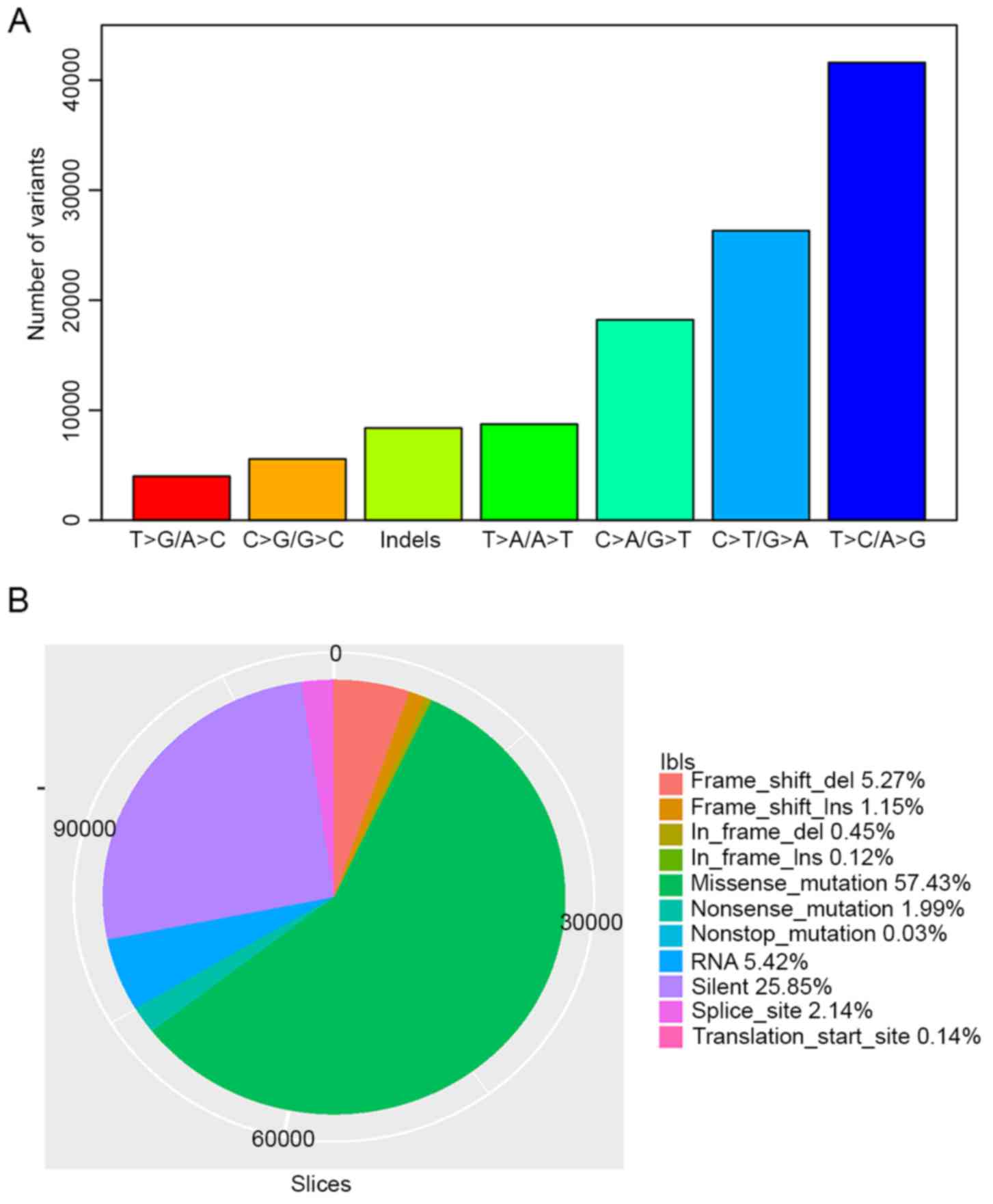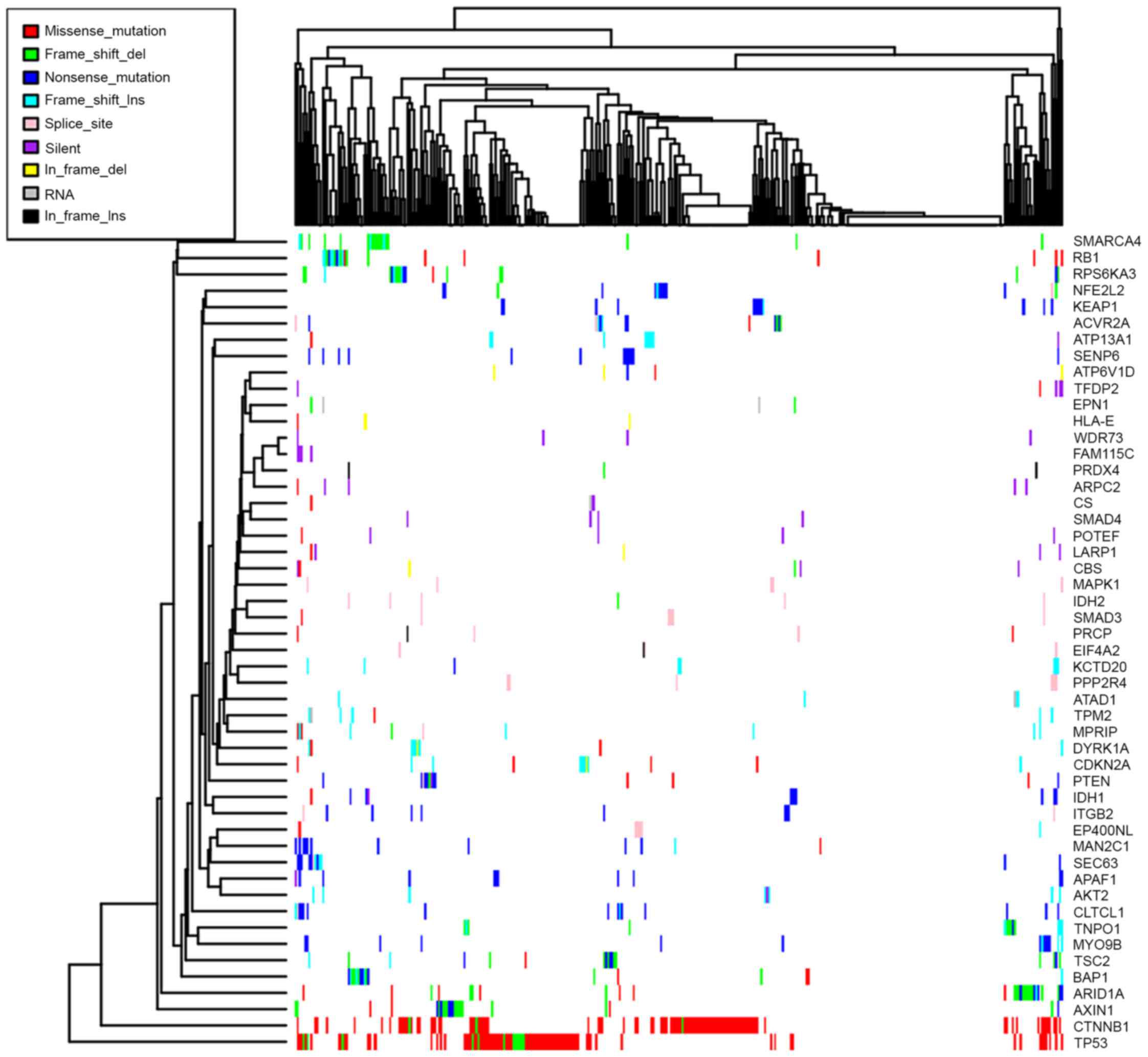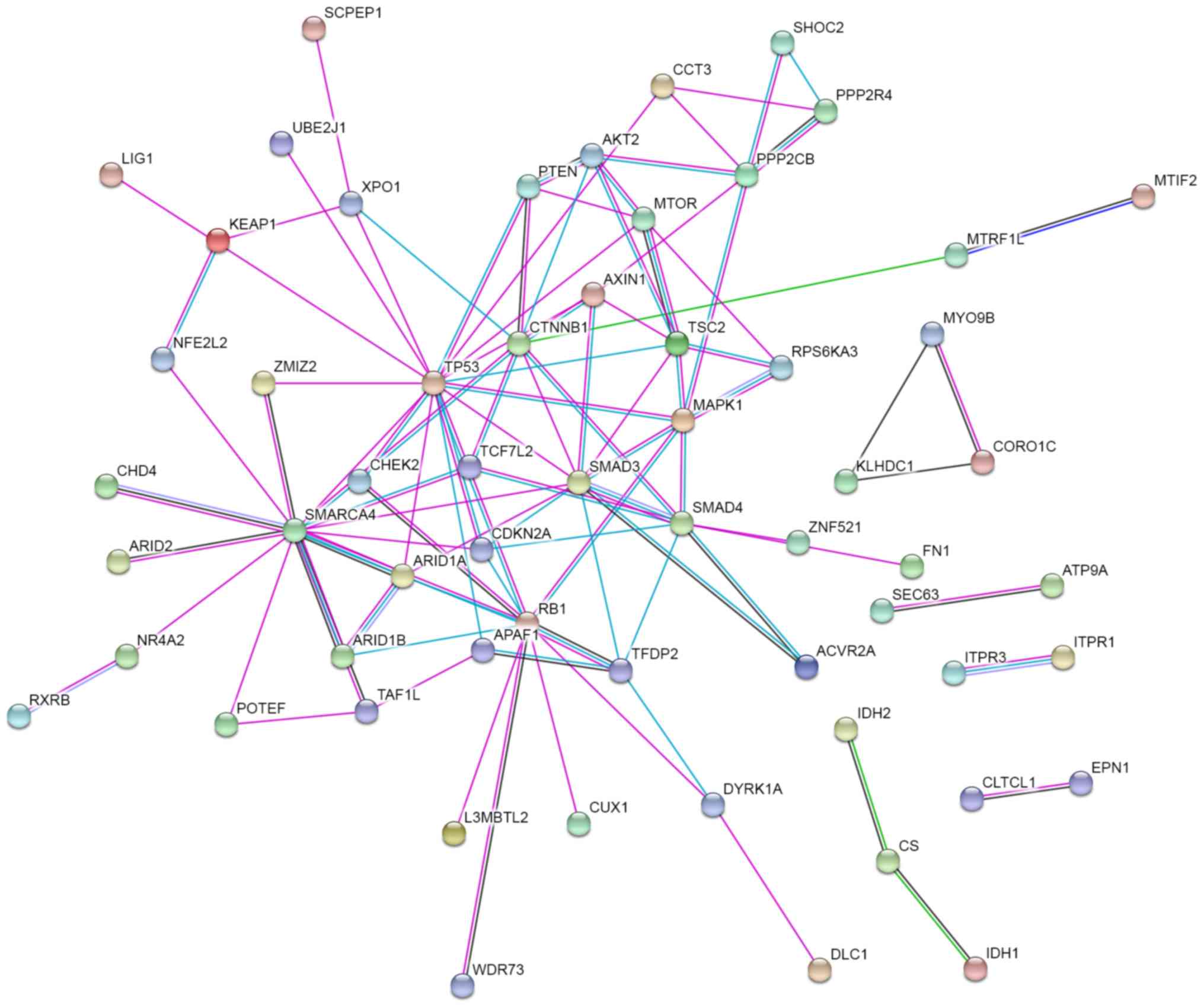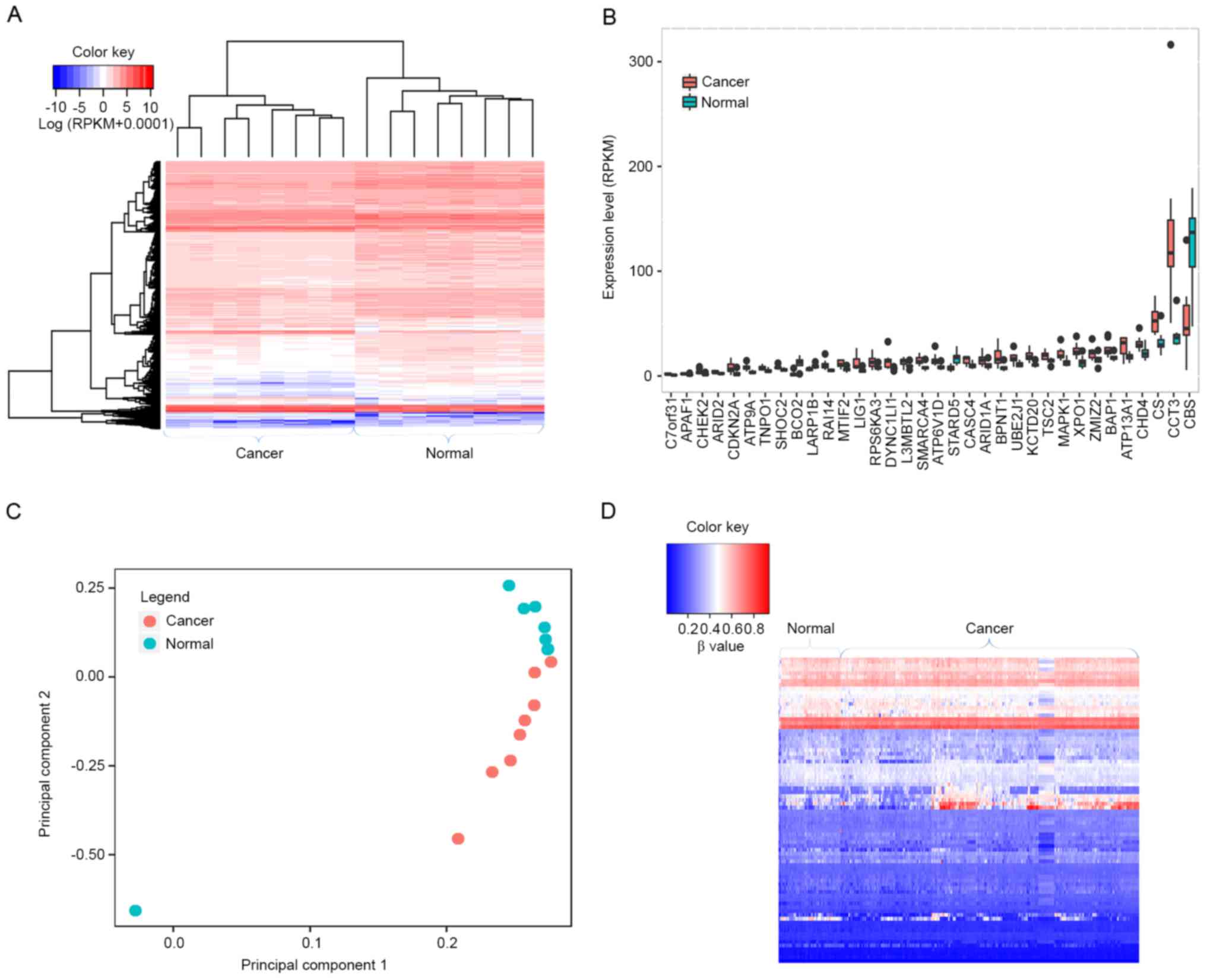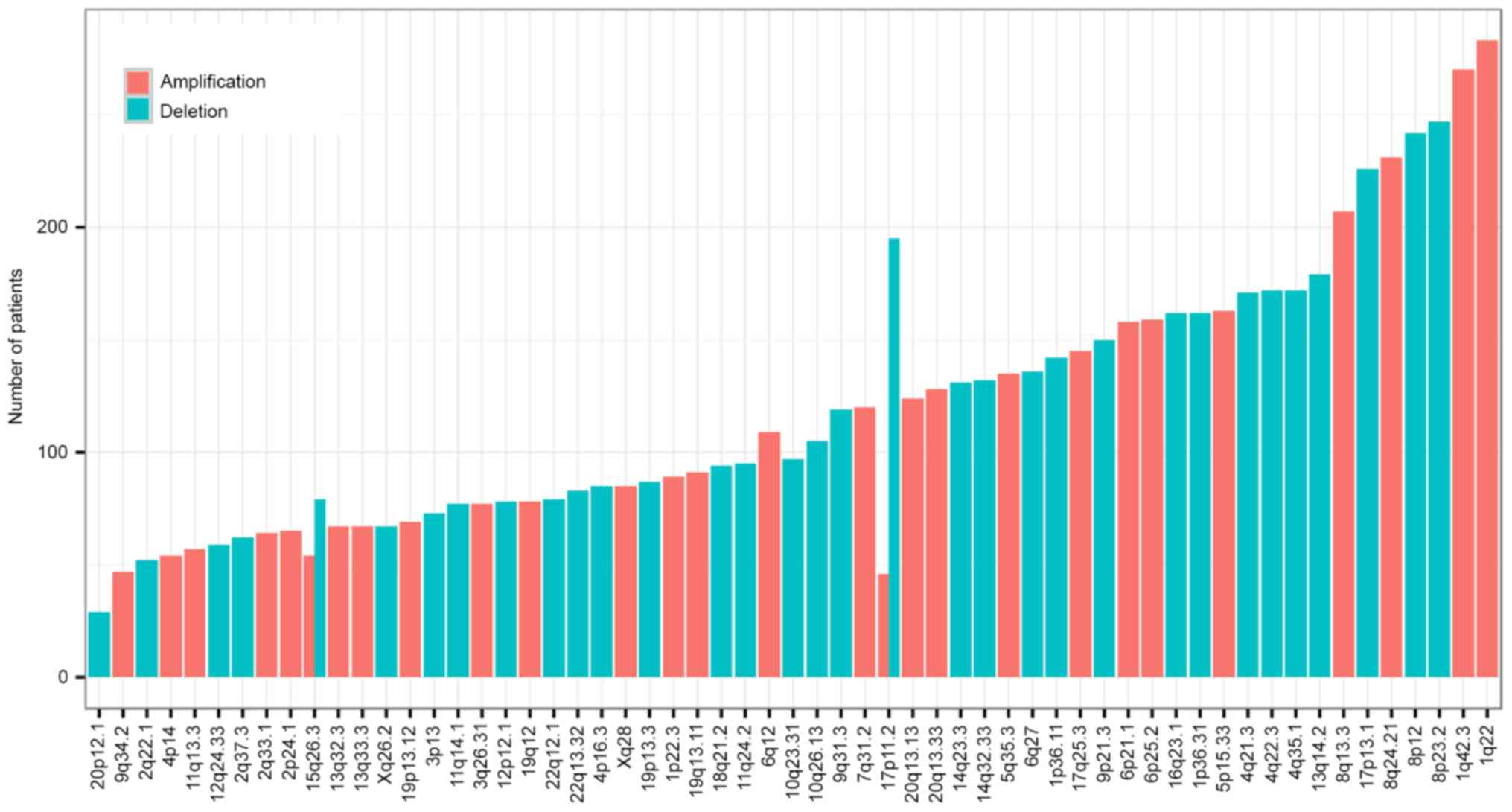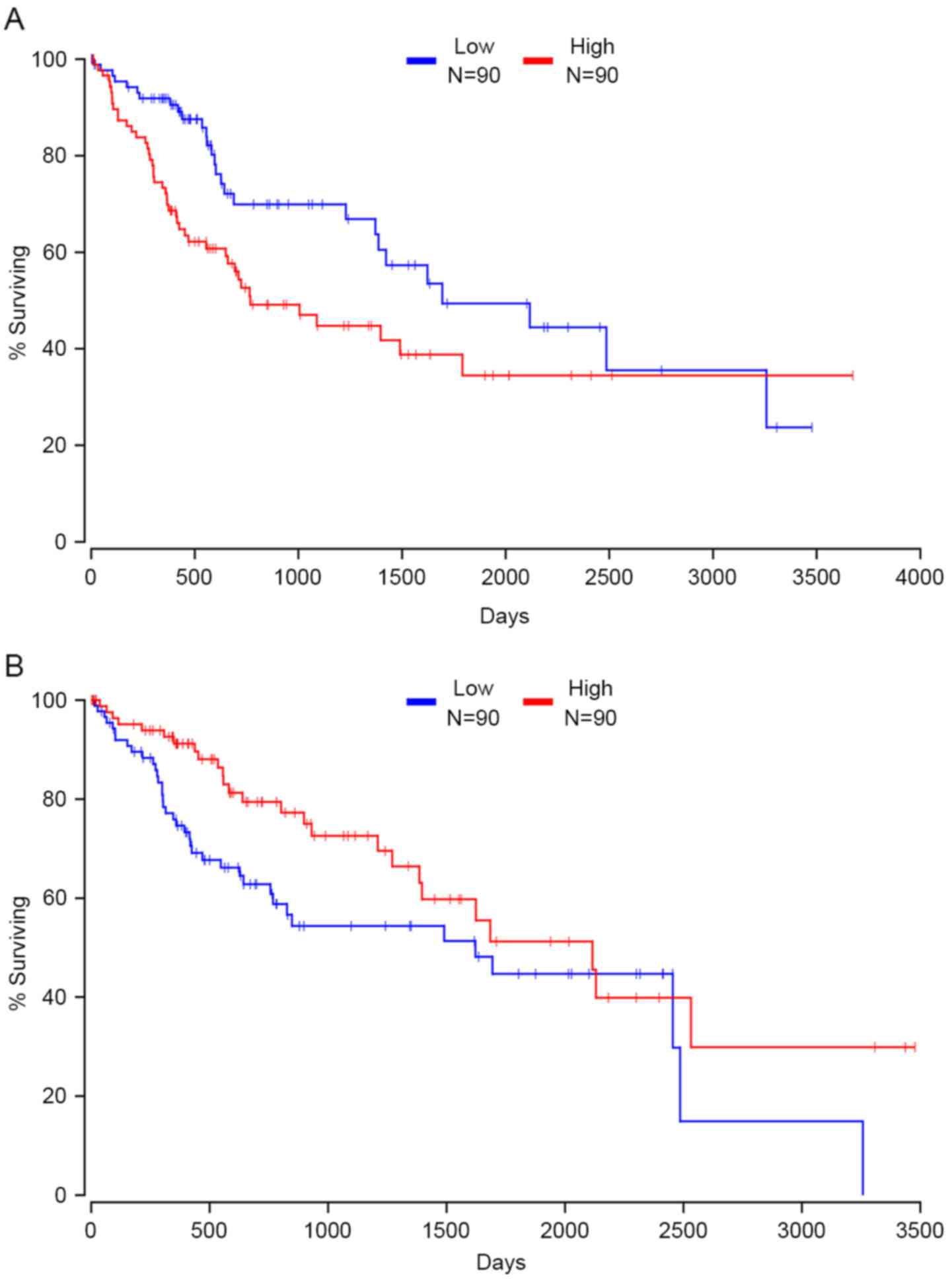Comprehensive characterization of cancer genes in hepatocellular carcinoma genomes
- Authors:
- Published online on: December 5, 2017 https://doi.org/10.3892/ol.2017.7521
- Pages: 1503-1510
-
Copyright: © Zhang et al. This is an open access article distributed under the terms of Creative Commons Attribution License.
Abstract
Introduction
Liver cancer is the fifth most prevalent type of cancer and the second most frequent cause of cancer-associated mortality in males, with an estimated 782,500 new cases and 745,500 deaths worldwide in 2012 (1). Hepatocellular carcinoma (HCC) is the most common type of liver cancer (2). HCC is particularly prevalent in East Asia, with an incidence rate twice that of Africa and >4 times higher than North America. However, the incidence rate of HCC has increased in Western countries (3). The dominant etiological cofactors that contribute to the incidence rate of HCC vary according to ancestry and region, including hepatitis B virus infection in East Asia and Africa, hepatitis C virus infection in Japan, aflatoxin B1 exposure in China and Africa and alcohol intake in Western countries (4,5).
Mutational disruption of driver genes and pathways occurs constantly in cancers, enabling tumor cells to proliferate without constraints. A number of cancer genomics studies intend to prioritize driver genes based on recurrent mutation status across a cohort of tumor samples (6,7). For instance, Totoki et al (8) applied MutSigCV to 503 pairs of HCC and matched non-cancerous liver tissues or blood and identified 30 recurrently mutated driver genes in HCC, including telomerase reverse transcriptase (TERT), catenin β1 (CTNNB1), tumor protein p53 (TP53), AT-rich interaction domain 2 (ARID2) and axin 1 (AXIN1). However, little attention has been paid to driver genes that are not frequently mutated, including genes that are enriched for mutations with high functional impact (FI) and genes with mutually exclusive mutation rates. Therefore, the development of computational tools that are able to detect moderate or low-frequency mutated driver genes is necessary to provide a more complete understanding of cancer genomics. Methods including Oncodrive-FM (9) aim to identify genes with a bias toward the enrichment of variants with a high FI, as measured by the Sorting Intolerant From Tolerant algorithm (10), PolyPhen2 (11) and Mutation Assessor (12). Another method, Dendrix (13), was constructed to uncover sets of genes which have at least one mutation in the majority of cancer samples. These bioinformatics tools, which complement existing methods, open novel avenues for the identification of potential driver genes involved in the tumorigenesis and progression of HCC.
In the present study, our group assessed the moderate or low-frequency mutated driver genes predicted by Oncodrive-FM and Dendrix in HCC. In addition to the previously reported driver genes, our group identified novel cancer-driving genes and pathways, including potential treatment targets and prognostic biomarkers. Then, aberrant expression of these driver genes, DNA methylation levels, copy number variations (CNVs) and correlation with prognosis were assessed in patients with HCC. The present study highlights the importance of analyzing cancer-driving genes in an integrated fashion, and provides insights into the carcinogenesis and progression of HCC.
Materials and methods
Classification of cancer mutations
A total of 112,980 somatic mutations, comprised of 104,595 single-nucleotide variants (SNVs) and 8,385 small insertions or deletions (indels), were generated by whole-exome sequencing of 377 tumor tissues and paired normal tissues, and this data was downloaded from The Cancer Genome Atlas (TCGA; http://cancergenome.nih.gov/, accessed on January 15, 2016) (14). Somatic mutations were classified into 11 categories based on their functional impacts in the coding genome using Ensembl Variant Effect Predictor (VEP) (15).
Prediction of driver genes and pathways
Driver genes and pathways were determined using OncodriveFM (https://www.intogen.org/analysis) and Dendrix (http://compbio.cs.brown.edu/projects/dendrix/) with default parameters following the criteria that genes and pathways have q values smaller than 0.05. To clarify the functional enrichment of driver genes, Gene Ontology (GO) terms (16,17) and Kyoto Encyclopedia of Genes and Genomes (KEGG) (18) pathway enrichment analyses were conducted for all the driver genes on the home page of STRING (http://string.embl.de/) (19). The GO terms and KEGG pathways were considered to be significantly enriched for driver genes with the cut-off of a false positive rate of P<0.05. Finally, a protein-protein interaction network was constructed with STRING to prioritize the pivotal driver genes in HCC. For each driver gene, the overall STRING score that represents the degree to which the driver gene is associated with other genes was computed by summing up combined STRING scores of all its protein-protein interactions.
Gene expression, DNA methylation and principal component analyses
The present study used expression data from Gao et al (20), which were generated by RNA sequencing of 8 paired HCC and normal tissues, and deposited in the Gene Expression Omnibus database (21) (accession no. GSE55758). DNA methylation data from 340 HCC samples were obtained from TCGA (14), and unavailable values were replaced with the mean β value. Differentially expressed and dysmethylated genes between HCC and normal tissues were determined using the function of t-test in R with the cutoff value of P<0.05. Next, principal component analysis (PCA) was conducted using the princomp function in R to examine whether the differentially expressed genes distinguished cancer tissues from normal tissues.
Sources of CNV and survival analyses
CNVs in 370 HCC samples, detected by single nucleotide polymorphism (SNP) array, were acquired from the Broad Institute TCGA GDAC Firehose (gdac.broadinstitute.org) (14). RNA sequencing (RNAseq) and clinical outcome data were retrieved from TCGA to further evaluate whether the expression of driver genes was associated with prognosis in 360/377 patients with HCC (14). For each driver gene, the patients with HCC were divided into high and low expression groups. The former refers to 25% (n=90) of patients with the highest RNA expression levels of the driver gene, while the latter refers to the 25% (n=90) of patients with the lowest expression levels of driver gene. Kaplan-Meier survival analyses were performed between the high and low expression groups using oncolnc (http://www.oncolnc.org/) (22) and the log-rank test was utilized to compare the difference of survival rates between different groups. P<0.05 was considered to indicate a statistically significant difference.
Results
Catalog of somatic mutations
A total of 112,980 somatic mutations generated by the whole-exome sequencing of 377 paired HCC and normal samples were downloaded from TCGA. Among them, 104,595, 8,385 mutations were SNVs and small indels, respectively. T>C/A>G, C>T/G>A and C>A/G>T were the three most prevalent transitions in HCC, with mutation rates of 36.82, 23.29 and 16.13% in all variant types (Fig. 1A). There were 64,890 missense mutations, 2,250 nonsense mutations, 34 nonstop mutations and 29,209 silent SNVs classified by VEP. In total, 505 deletions and 135 insertions caused translational frame shifts, while 5,957 deletions and 1,302 insertions were in frame mutations. A total of 2,419 and 155 mutations occurred in splicing sites and translation start sites, respectively. Over 60% (72,149/112,980) of total variants were non-synonymous mutations (Fig. 1B). HCC has a lower nonsynonymous mutation density (2.03 nonsynonymous mutations per Mb per sample, on average) in comparison with other types of cancer, including melanoma and lung cancer (6).
Cancer driver genes and pathways in HCC
OncodriveFM was used to identify driver genes and pathways in HCC. In total, 108 driver genes were identified by OncodriveFM. Among them, TP53, CTNNB1, ARID2, AXIN1 and TERT were known driver genes, with mutation rates of 30.69, 27.11, 11.00, 7.16 and 2.05% across all HCC samples (8). However, the majority of driver genes were middle or low-frequency mutated genes, Fig. 2 presents the mutation patterns of the 50 most frequently mutated driver genes, however data are not shown for the remaining driver genes. Dendrix analysis was performed for sets of size ranging from 2 to 4. When k=2, the pair TP53 and CTNNB1 was sampled with a frequency of 24% (240/1,000). When k=3, the triplet [BRCA associated protein 1 (BAP1), TP53 and CTNNB1] was sampled with a frequency of 5.4% (54/1,000). For k=4, no gene set had a sample frequency >1%. The pair (TP53 and CTNNB1) and triplet (BAP1, TP53 and CTNNB1) were the most prevalent gene sets in the mutual exclusivity test, further supporting the importance of TP53 and CTNNB1 in the tumorigenesis of HCC.
The enrichment of GO terms was performed for 109 cancer genes on STRING, and 80 biological processes, 36 molecular functions and 47 cellular components were reported with statistical significance. The GO terms represented a wide variety of functional processes, including ‘regulation of protein metabolic process’, ‘regulation of cellular process’, ‘regulation of gene expression’, ‘cell cycle’ and ‘cellular component biogenesis and organization’, indicating that driver gene candidates are actively involved in cancer-associated processes in HCC (data not shown). The 109 driver genes were significantly enriched in 58 KEGG pathways, including ‘cell cycle’, ‘p53 signaling pathway’, ‘mTOR signaling pathway’ and ‘PI3K-Akt signaling pathway’ (data not shown). In addition, Oncodrive-FM also identified 119 pathways with statistical FI bias in HCC, including ‘colorectal cancer’, ‘endometrial cancer’, ‘basal cell carcinoma’, ‘thyroid cancer’, ‘prostate cancer’, ‘glioma’, ‘wnt signaling pathway’, ‘pathways in cancer’, ‘p53 signaling pathway’, ‘pancreatic cancer’, ‘non-small cell lung cancer’ and ‘melanoma’ (data not shown). A total of 71.19% (42/59) of driver gene-enriched pathways were overlapped with driver pathways in HCC. Finally, a protein-protein interaction network was constructed with STRING to prioritize the pivotal driver genes. As presented in Fig. 3, TP53, SWI/SNF related, matrix associated, actin dependent regulator of chromatin, subfamily a, member 4 (SMARCA4), smad family member 3, RB transcriptional corepressor 1 (RB1), CTNNB1, smad family member 4 (SMAD4), mitogen-activated protein kinase 1 (MAPK1) and TSC complex subunit 2 are at the core of the protein-protein interaction network. This suggests that they may serve key functions in the network, because they possessed the strongest protein-protein interactions (overall STRING score >5; data not shown).
Expression profiling and DNA methylation analyses in HCC
To analyze the gene expression profile in HCC, RNA-seq data from 8 paired HCC and normal tissues were obtained. Overall, 4,665 differentially expressed genes were identified between the 8 paired HCC and normal samples (Fig. 4A), of which 34 were driver gene candidates, including transportin 1 (TNPO1), apoptotic peptidase activating factor 1 (APAF1), AT-rich interaction domain 1A (ARID1A) and BAP1 (Fig. 4B). PCA was applied to examine whether differentially expressed genes were able to discriminate cancer tissues from normal tissues. As presented in Fig. 4C, normal tissues were aggregated to the upper side of the graph, whereas cancer tissues were clustered to the lower side, suggesting that differentially expressed genes were able to separate the tissue samples into two distinct groups.
DNA methylation of cytosine within CpG dinucleotides maintains the proper regulation of gene expression and stable gene silencing; therefore, DNA methylation alterations make a substantial contribution to tumorigenesis (23). In order to characterize the DNA methylation status of driver gene candidates, our group downloaded DNA methylation data from TCGA and analyzed the DNA methylation levels of the identified driver genes in HCC. Overall, 83 driver gene candidates had dysmethylation at their promoters, including 45 hypomethylated and 38 hypermethylated driver genes (Fig. 4D). These results suggest that the majority of driver genes may be implicated in HCC through modulating methylation status. 13 driver genes are overexpressed and hypomethylated, including chaperonin containing TCP1 subunit 3 (CCT3), checkpoint kinase 2 (CHEK2), SMARCA4, MAPK1, TNPO1 and mitochondrial translational initiation factor 2, suggesting they may have oncogenic functions in HCC. In contrast, β-carotene oxygenase 2 (BCO2) and cystathionine-β-synthase (CBS) exhibited hypermethylation and low expression, and may therefore function as tumor suppressors in HCC.
CNVs in HCC
CNVs of 370 HCC samples detected by SNParray were also obtained from the Broad Institute. Significant focal gains and deletions (q<0.25) were identified in 360 samples (360/370, 97.30%) at 61 loci (34 amplifications and 27 deletions). Among these, amplifications at 1q22 and 1q42.3 and deletions at 8p23.2 and 8p12 were the most frequent CNVs in HCC, with occurrence rates of 76.49% (90/370), 72.97% (89/370), 66.76% (89/370) and 65.41% (90/370), respectively (Fig. 5). A total of 17 cancer driver genes were involved in CNVs, including known tumor suppressors and oncogenes, for example TP53 (deletion, 17p13.1), phosphatase and tensin homolog (deletion, 10q23.31) and RB1 (deletion 13q14.2). Multiple driver candidates were also implicated in the CNVs, including SHOC2, leucine rich repeat scaffold protein (deletion, 10q25.2), transcription factor 7 like 2 (TCF7L2; deletion, 10q25.2), SMAD4 (deletion, 18q21.2), TRPM8 channel associated factor 2 (deletion, 7q35), isocitrate dehydrogenase [NADP (+2)] mitochondrial (IDH2) and DNA polymerase γ, catalytic subunit (deletion, 15q26.1), solute carrier family 2 member 6 (deletion, 9q34.2), outer dense fiber of sperm tails 2 and protein phosphatase 2 phosphatase activator (deletion, 9q34.11), ARID1A (deletion, 1p36.11), cut like homeobox 1 (deletion, 7q22.1), cyclin dependent kinase inhibitor 2A (CDKN2A; deletion, 9p21.3), BCO2 (deletion, 11q23.1) and EP400 N-terminal like (deletion, 12q24.33).
Survival analyses
TCGA RNAseq and clinical outcome data were acquired from TCGA to evaluate whether the expression of 109 driver genes is associated with survival and prognosis in patients with HCC. Kaplan-Meier survival analysis showed that the expression of 24 driver genes was significantly associated with clinical outcomes in patients with HCC. High expression of 14 driver genes indicated worse survival rates in patients with HCC, including AXIN1, serine carboxypeptidase 1, APAF1, TRPM8 channel associated factor 2, actin related protein 2/3 complex subunit 2, autophagy related 9A, exportin 1 (XPO1), Basic Leucine Zipper and W2 domains 2, CCT3, CDKN2A, chromodomain helicase DNA binding protein 4, coronin 1C, RAB32, member RAS oncogene family and TNPO1. Fig. 6A presents the correlation between the expression of XPO1 and patients' clinical outcome; data are not shown for the remaining driver genes (Fig. 6A). In contrast, patients with high expression of 10 other driver genes had a relatively favorable prognosis, including kinesin 2, BCO2, cancer susceptibility 4, GTF2I repeat domain containing 2B, major histocompatibility complex, class I, E, IDH2, La ribonucleoprotein domain family member 1B, mannosidase alpha class 2C member 1, zinc finger protein 521 and StAR related lipid transfer domain containing 5 (data not shown). TNPO1 and CCT3 were hypomethylated, overexpressed and associated with a poor prognosis in HCC. BCO2 was hypermethylated, under-expressed and associated with a favorable prognosis in HCC. These three driver genes may be potential targets for treatment and prognostic biomarkers for patients with HCC in the future.
Discussion
In the present study, our group conducted an integrated investigation of 109 cancer-driving genes and 119 pathways determined with Oncodrive-FM and Dendrix. Only a small fraction of these driver genes are repeatedly mutated in HCC samples, including TP53, CTNNB1, ARID2, AXIN1 and TERT (8). The P53-retinoblastoma (RB) signaling pathway was consistently mutated in cancer samples, including TP53 and CHEK2 of the P53 pathway, and RB1 and CDKN2A of the RB pathway, reflecting the inactivation of the P53-RB pathway in HCC. In addition to those identified in the P53-RB pathway, inactivating mutations were frequently observed in WNT pathway genes, including AXIN1 and CTNNB1. Multiple cancer driver genes initially identified in other types of cancer were first identified as drivers in HCC, including BAP1 in renal cell carcinoma (24), IDH2 in angioimmunoblastic T-cell lymphoma (25), CDKN2A in melanoma (26), TCF7L2 in colorectal cancer (27) and SMAD4 in colorectal and pancreatic cancer (28). In addition, multiple novel driver candidates were identified by our group; for instance, LARP1 and APAF1. LARP1, as a conserved RNA-binding protein, interacts with poly-A-binding protein and modulates 5′-terminal oligopyrimidine tract mRNA translation. Enhanced expression of LARP1 increases cell migration, invasion, growth and tumorigenicity in vivo through post-transcriptionally altering gene expression, including mechanistic target of rapamycin, in Hela cells (29). APAF1 is an important factor that regulates the mitochondrial apoptotic pathway, and loss of APAF1 causes cellular resistance against apoptotic signals. Reduced expression of APAF1 has been observed in colorectal adenocarcinoma and is associated with deeper tumor invasion, frequent lymph node metastasis, higher stage and poorer differentiation (30). In addition, APAF1 is frequently methylated in bladder and kidney cancer, and demethylation of APAF1 increased APAF1 expression and inhibited the proliferation of bladder and kidney cancer cell lines (31).
One notable strength of OncodriveFM and Dendrix analysis lies in the identification of cancer-associated genes and pathways which have a high FI bias towards accumulating high FI variants or mutational exclusivity, independent of cancer mutation frequency. Implementing these tools allows for a comprehensive exploration of cancer-driving genes and pathways. In addition, our group revealed 35 differentially expressed genes, 83 dysmethylated driver genes and 17 cancer driver genes involved in CNVs, suggesting these genes may contribute to the development and progression of HCC in various ways.
Of the 109 driver gene candidates, 24 genes whose expression levels were associated with HCC patient prognosis were identified, including XPO1 and IDH2. XPO1, also known as CRM1, encodes a protein which serves a critical function in the trafficking of over 230 proteins, including tumor suppressors (for example, p53, p73 and forkhead box O1), growth regulator/pro-inflammatory (for example, IκB, Rb, p21, p27, BRCA1, DNA repair associated and APC, WNT signaling pathway regulator), and anti-apoptotic proteins (for example, nucleophosmin 1 and AP-1) (32). XPO1 is an oncogenic, anti-apoptotic protein in transformed cells and is overexpressed in a number of types of cancer, including mantle cell lymphoma (33), lung adenocarcinoma (34) and gastric cancer (35). Similar to the results of the present study, high expression of XPO1 is an independent poor prognostic factor in gastric carcinoma (35), acute myeloid leukemia (36), pancreatic cancer (37) and lung adenocarcinoma (34). Another gene, IDH2, is frequently mutated in multiple types of cancer, including T-cell lymphoma (38), glioma (39) and acute myeloid leukemia (40). In line with the results of the present study, Liu et al (41) reported that decreased expression of IDH2 was associated with lower overall survival rates in HCC. Furthermore, mutated IDH2 was an independent prognostic factor for improved overall survival in acute myeloid leukemia (40) and glioma (42). Therefore, these genes may be ideal candidates for the development of HCC prognostic indicators in future studies.
In summary, our group have successfully compiled a list of cancer driver genes and pathways in HCC, enhancing our understanding of pathogenesis and progression of HCC. Furthermore, the novel driver genes and pathways identified by the present study pave the way for the development of therapies targeting driver genes and prognostic biomarkers in HCC.
References
|
Torre LA, Bray F, Siegel RL, Ferlay J, Lortet-tieulent J and Jemal A: Global cancer statistics, 2012. CA Cancer J Clin. 65:87–108. 2015. View Article : Google Scholar : PubMed/NCBI | |
|
Massarweh NN and El-Serag HB: Epidemiology of hepatocellular carcinoma and intrahepatic cholangiocarcinoma. Cancer Control. 24:10732748177292452017. View Article : Google Scholar : PubMed/NCBI | |
|
Center MM and Jemal A: International trends in liver cancer incidence rates. Cancer Epidemiol Biomarkers Prev. 20:2362–2368. 2011. View Article : Google Scholar : PubMed/NCBI | |
|
Yu J, Shen J, Sun TT, Zhang X and Wong N: Obesity, insulin resistance, NASH and hepatocellular carcinoma. Semin Cancer Biol. 23:483–491. 2013. View Article : Google Scholar : PubMed/NCBI | |
|
Augustine MM and Fong Y: Epidemiology and risk factors of biliary tract and primary liver tumors. Surg Oncol Clin N Am. 23:177–188. 2014. View Article : Google Scholar | |
|
Lawrence MS, Stojanov P, Polak P, Kryukov GV, Cibulskis K, Sivachenko A, Carter SL, Stewart C, Mermel CH, Roberts SA, et al: Mutational heterogeneity in cancer and the search for new cancer-associated genes. Nature. 499:214–218. 2013. View Article : Google Scholar : PubMed/NCBI | |
|
Dees ND, Zhang Q, Kandoth C, Wendl MC, Schierding W, Koboldt DC, Mooney TB, Callaway MB, Dooling D, Mardis ER, et al: MuSiC: Identifying mutational significance in cancer genomes. Genome Res. 22:1589–1598. 2012. View Article : Google Scholar : PubMed/NCBI | |
|
Totoki Y, Tatsuno K, Covington KR, Ueda H, Creighton CJ, Kato M, Tsuji S, Donehower LA, Slagle BL, Nakamura H, et al: Trans-ancestry mutational landscape of hepatocellular carcinoma genomes. Nat Genet. 46:1267–1273. 2014. View Article : Google Scholar : PubMed/NCBI | |
|
Gonzalez-Perez A and Lopez-Bigas N: Functional impact bias reveals cancer drivers. Nucleic Acids Res. 40:e1692012. View Article : Google Scholar : PubMed/NCBI | |
|
Sim NL, Kumar P, Hu J, Henikoff S, Schneider G and Ng PC: SIFT web server: Predicting effects of amino acid substitutions on proteins. Nucleic Acids Res. 40(Web Server Issue): W452–W457. 2012. View Article : Google Scholar : PubMed/NCBI | |
|
Adzhubei IA, Schmidt S, Peshkin L, Ramensky VE, Gerasimova A, Bork P, Kondrashov AS and Sunyaev SR: A method and server for predicting damaging missense mutations. Nat Methods. 7:248–249. 2010. View Article : Google Scholar : PubMed/NCBI | |
|
Reva B, Antipin Y and Sander C: Predicting the functional impact of protein mutations: Application to cancer genomics. Nucleic Acids Res. 39:e1182011. View Article : Google Scholar : PubMed/NCBI | |
|
Vandin F, Upfal E and Raphael BJ: De novo discovery of mutated driver pathways in cancer. Genome Res. 22:375–385. 2012. View Article : Google Scholar : PubMed/NCBI | |
|
Cancer Genome Atlas Research Network, . Electronic address. simplewheeler@bcm.eduCancer Genome Atlas Research Network: Comprehensive and integrative genomic characterization of hepatocellular carcinoma. Cell. 169:1327–1341.e23. 2017. View Article : Google Scholar : PubMed/NCBI | |
|
McLaren W, Pritchard B, Rios D, Chen Y, Flicek P and Cunningham F: Deriving the consequences of genomic variants with the ensembl API and SNP effect predictor. Bioinformatics. 26:2069–2070. 2010. View Article : Google Scholar : PubMed/NCBI | |
|
Ashburner M, Ball CA, Blake JA, Botstein D, Butler H, Cherry JM, Davis AP, Dolinski K, Dwight SS, Eppig JT, et al: Gene ontology: Tool for the unification of biology. The Gene Ontology Consortium. Nat Genet. 25:25–29. 2000. View Article : Google Scholar : PubMed/NCBI | |
|
The Gene Ontology Consortium, . Expansion of the gene ontology knowledgebase and resources. Nucleic Acids Res. 45:D331–D338. 2017. View Article : Google Scholar : PubMed/NCBI | |
|
Kanehisa M, Furumichi M, Tanabe M, Sato Y and Morishima K: KEGG: New perspectives on genomes, pathways, diseases and drugs. Nucleic Acids Res. 45:D353–D361. 2017. View Article : Google Scholar : PubMed/NCBI | |
|
Szklarczyk D, Morris JH, Cook H, Kuhn M, Wyder S, Simonovic M, Santos A, Doncheva NT, Roth A, Bork P, et al: The STRING database in 2017: Quality-controlled protein-protein association networks, made broadly accessible. Nucleic Acids Res. 45:D362–D368. 2017. View Article : Google Scholar : PubMed/NCBI | |
|
Gao F, Liang H, Lu H, Wang J, Xia M, Yuan Z, Yao Y, Wang T, Tan X, Laurence A, et al: Global analysis of DNA methylation in hepatocellular carcinoma by a liquid hybridization capture-based bisulfite sequencing approach. Clin Epigenetics. 7:862015. View Article : Google Scholar : PubMed/NCBI | |
|
Barrett T, Wilhite SE, Ledoux P, Evangelista C, Kim IF, Tomashevsky M, Marshall KA, Phillippy KH, Sherman PM, Holko M, et al: NCBI GEO: Archive for functional genomics data sets-Update. Nucleic Acids Res. 41(Database Issue): D991–D995. 2013.PubMed/NCBI | |
|
Anaya J: OncoLnc: Linking TCGA survival data to mRNAs, miRNAs and lncRNAs. PeerJ Comput Sci. 2:e672016. View Article : Google Scholar | |
|
Kulis M and Esteller M: 2-DNA methylation and cancerEpigenetics and Cancer, Part A. 70. Herceg Z and Ushijima TBT-A G: Academic Press; pp. 27–56. 2010, View Article : Google Scholar | |
|
Sato Y, Yoshizato T, Shiraishi Y, Maekawa S, Okuno Y, Kamura T, Shimamura T, Sato-Otsubo A, Nagae G, Suzuki H, et al: Integrated molecular analysis of clear-cell renal cell carcinoma. Nat Genet. 45:860–867. 2013. View Article : Google Scholar : PubMed/NCBI | |
|
Wang C, Mckeithan TW, Gong Q, Zhang W, Bouska A, Rosenwald A, Gascoyne RD, Wu X, Wang J, Muhammad Z, et al: IDH2R172 mutations define a unique subgroup of patients with angioimmunoblastic T-cell lymphoma. Blood. 126:1741–1752. 2015. View Article : Google Scholar : PubMed/NCBI | |
|
Betti M, Aspesi A, Biasi A, Casalone E, Ferrante D, Ogliara P, Gironi LC, Giorgione R, Farinelli P, Grosso F, et al: CDKN2A and BAP1 germline mutations predispose to melanoma and mesothelioma. Cancer Lett. 378:120–130. 2016. View Article : Google Scholar : PubMed/NCBI | |
|
Nome T, Hoff AM, Bakken AC, Rognum TO, Nesbakken A and Skotheim RI: High frequency of fusion transcripts involving TCF7L2 in colorectal cancer: Novel fusion partner and splice. PLoS One. 9:e912642014. View Article : Google Scholar : PubMed/NCBI | |
|
Inamoto S, Itatani Y, Yamamoto T, Minamiguchi S, Hirai H, Iwamoto M, Hasegawa S, Taketo MM, Sakai Y and Kawada K: Loss of SMAD4 promotes colorectal cancer progression by accumulation of myeloid-derived suppressor cells through the CCL15-CCR1 chemokine axis. Clin Cancer Res. 22:492–501. 2016. View Article : Google Scholar : PubMed/NCBI | |
|
Mura M, Hopkins TG, Michael T, Abd-Latip N, Weir J, Aboagye E, Mauri F, Jameson C, Sturge J, Gabra H, et al: LARP1 post-transcriptionally regulates mTOR and contributes to cancer progression. Oncogene. 34:5025–5036. 2015. View Article : Google Scholar : PubMed/NCBI | |
|
Paik SS, Jang KS, Song YS, Jang SH, Min KW, Han HX, Na W, Lee KH, Choi D and Jang SJ: Reduced expression of Apaf-1 in colorectal adenocarcinoma correlates with tumor progression and aggressive phenotype. Ann Surg Oncol. 14:3453–3459. 2007. View Article : Google Scholar : PubMed/NCBI | |
|
Christoph F, Kempkensteffen C, Weikert S, Köllermann J, Krause H, Miller K, Schostak M and Schrader M: Methylation of tumour suppressor genes APAF-1 and DAPK-1 and in vitro effects of demethylating agents in bladder and kidney cancer. Br J Cancer. 95:1701–1707. 2006. View Article : Google Scholar : PubMed/NCBI | |
|
Ishizawa J, Kojima K, Hail N Jr, Tabe Y and Andreeff M: Expression, function, and targeting of the nuclear exporter chromosome region maintenance 1 (CRM1) protein. Pharmacol Ther. 153:25–35. 2015. View Article : Google Scholar : PubMed/NCBI | |
|
Yoshimura M, Ishizawa J, Ruvolo V, Dilip A, Quintás-Cardama A, McDonnell TJ, Neelapu SS, Kwak LW, Shacham S, Kauffman M, et al: Induction of p53-mediated transcription and apoptosis by exportin-1 (XPO1) inhibition in mantle cell lymphoma. Cancer Sci. 105:795–801. 2014. View Article : Google Scholar : PubMed/NCBI | |
|
Gao W, Lu C, Chen L and Keohavong P: Overexpression of CRM1: A characteristic feature in a transformed phenotype of lung carcinogenesis and a molecular target for lung cancer adjuvant therapy. J Thorac Oncol. 10:815–825. 2015. View Article : Google Scholar : PubMed/NCBI | |
|
Zhou F, Qiu W, Yao R, Xiang J, Sun X, Liu S, Lv J and Yue L: CRM1 is a novel independent prognostic factor for the poor prognosis of gastric carcinomas. Med Oncol. 30:7262013. View Article : Google Scholar : PubMed/NCBI | |
|
Kojima K, Kornblau SM, Ruvolo V, Dilip A, Duvvuri S, Davis RE, Zhang M, Wang Z, Coombes KR, Zhang N, et al: Prognostic impact and targeting of CRM1 in acute myeloid leukemia. Blood. 121:4166–4174. 2013. View Article : Google Scholar : PubMed/NCBI | |
|
Huang WY, Yue L, Qiu WS, Wang LW, Zhou XH and Sun YJ: Prognostic value of CRM1 in pancreas cancer. Clin Invest Med. 32:E3152009. View Article : Google Scholar : PubMed/NCBI | |
|
Cairns RA, Iqbal J, Lemonnier F, Kucuk C, de Leval L, Jais JP, Parrens M, Martin A, Xerri L, Brousset P, et al: IDH2 mutations are frequent in angioimmunoblastic T-cell lymphoma. Blood. 119:1901–1903. 2012. View Article : Google Scholar : PubMed/NCBI | |
|
Koh J, Cho H, Kim H, Kim SI, Yun S, Park CK, Lee SH, Choi SH and Park SH: IDH2 mutation in gliomas including novel mutation. Neuropathology. 35:236–244. 2015. View Article : Google Scholar : PubMed/NCBI | |
|
Green CL, Evans CM, Zhao L, Hills RK, Burnett AK, Linch DC and Gale RE: The prognostic significance of IDH2 mutations in AML depends on the location of the mutation. Blood. 118:409–412. 2011. View Article : Google Scholar : PubMed/NCBI | |
|
Liu WR, Tian MX, Jin L, Yang LX, Ding ZB, Shen YH, Peng YF, Zhou J, Qiu SJ, Dai Z, et al: High expression of 5-hydroxymethylcytosine and isocitrate dehydrogenase 2 is associated with favorable prognosis after curative resection of hepatocellular carcinoma. J Exp Clin Cancer Res. 33:322014. View Article : Google Scholar : PubMed/NCBI | |
|
Wang XW, Ciccarino P, Rossetto M, Boisselier B, Marie Y, Desestret V, Gleize V, Mokhtari K, Sanson M and Labussière M: IDH mutations: Genotype-phenotype correlation and prognostic impact. Biomed Res Int. 2014:5402362014.PubMed/NCBI |



